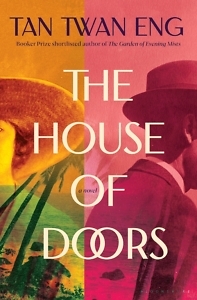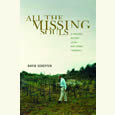Romance and Revolution
Tan Twan Eng’s The House of Doors creates a world of false facades and alter egos
The title of Tan Twan Eng’s new novel, The House of Doors, comes from a scene when the protagonist, Lesley Hamlyn, visits a wealthy friend’s private collection of decorated doors, dozens of them “suspended on wires so thin they seemed to be floating in the air.” Walking among them, she has “the dizzying sensation … of a constantly shifting maze, each pair of doors opening into another passageway, and another, giving me no inkling of where I would eventually emerge.”

The novel as a whole possesses a similar multiform quality, with illusions and reality layered in profuse combinations. Stable marriages are revealed to be shams, old friends conceal their identities, and political operatives manipulate crowds to garner support. In Tan’s world of false facades and alter egos, it’s hard enough to distinguish friends from adversaries; what is more difficult is learning the truth about yourself.
The primary action of the novel takes place in Penang in 1921, then a part of the UK’s Straits Settlement on the Malay Peninsula (and Tan’s birthplace). Lesley Hamlyn and her husband Robert, a colonial lawyer, receive a visit from the celebrated writer W. Somerset “Willie” Maugham, a friend of Robert’s from decades earlier in London. Both men undergo personal crises. Robert, suffering from a lung ailment, wants to move his family to the dry plains of South Africa. Maugham, who travels with his “personal secretary” Gerald Haxton, learns in Penang that a risky investment, which he hoped would provide him financial freedom, has instead failed utterly, leaving him virtually penniless.
The narrative spine is the burgeoning relationship between Lesley and Willie. Though initially put off by Willie’s fame and his demands as a guest, Lesley begins to confide in him. In turn, Willie reveals his financial catastrophe and confesses that he needs a sensational new story to help refill his coffers. Lesley has just the inspiration he needs. Knowing Willie’s taste for “unhappy marriages and adulterous affairs,” she shares the untold side of a scandal involving a friend of hers that rocked Penang in 1910, when the wife of a schoolmaster shot and killed a man whom she claimed attempted to rape her. As Lesley unfolds the details of the trial and the gossip surrounding that unfortunate woman, she also relates dark secrets that belie the basis of her own, apparently blissful marriage. The novel’s refrain, “Every marriage has its own rules,” seems universal.
 Tan, whose earlier novels The Gift of Rain and The Garden of Evening Mists contain echoes of Maugham’s work, follows the old master’s pattern of braiding domestic drama with political tension. Willie’s visit to the Hamlyns and his questions about the province prompt Lesley to recall a visit a decade earlier from Dr. Sun Yat Sen, the Chinese leader who was determined to overthrow the Manchu emperors. Willie suspects that Lesley’s interest in the handsome revolutionary extended beyond admiring his dream of liberating China’s peasants. Tan’s portrayal of the tension between white colonials and native populations in the years before and after The Great War suggests that the era of British domination was nearing its end.
Tan, whose earlier novels The Gift of Rain and The Garden of Evening Mists contain echoes of Maugham’s work, follows the old master’s pattern of braiding domestic drama with political tension. Willie’s visit to the Hamlyns and his questions about the province prompt Lesley to recall a visit a decade earlier from Dr. Sun Yat Sen, the Chinese leader who was determined to overthrow the Manchu emperors. Willie suspects that Lesley’s interest in the handsome revolutionary extended beyond admiring his dream of liberating China’s peasants. Tan’s portrayal of the tension between white colonials and native populations in the years before and after The Great War suggests that the era of British domination was nearing its end.
Tan’s novel, gripping for any reader, holds special appeal for fans of Maugham and his work. Tan depicts Willie’s routine — dawn walk, breakfast, and shower, followed by four hours of writing — and makes repeated references to his popular fiction. Everyone, it appears, has read his famous story “Rain”; some are offended by its prostitute heroine, but most want to know when he will write something equally exquisite. Willie himself speaks of his novels Cakes and Ale, The Moon and Sixpence, and The Painted Veil as if they are wise fables that illustrate deep, painful truths.
Tan’s Willie emerges as crow-like, attracted to shiny objects and unabashed about repurposing his friends’ confidences in fiction. Surely, he rationalizes, when they unburden themselves to a writer, they know there’s a chance he will use them in stories. But not just any story is worthy of retelling. In Willie’s view, a “love interest” is essential: “a story without love,” he says, “well, it just wouldn’t work.”
The House of Doors, which shifts in time from 1921 to 1910 to 1947, plays clever games with the connections between fiction and history. Tan points out in the acknowledgments that his novel “features” the murder trial of Ethel Proudlock, Lesley’s friend who appears by name here (though Tan pushes the date of the trial back one year). That same case provided real-life Maugham with material for “The Letter,” a story that appears in The Causarina Tree, a copy of which Willie sends to Lesley 25 years after his visit to Penang. Tan doesn’t mention that Maugham, who had a nose for good material, also adapted that story into a stage play, which was then used in four different cinematic versions, each with a different inflection on the original story — a constantly shifting maze, indeed.

Sean Kinch grew up in Austin and attended Stanford. He earned a Ph.D. from the University of Texas. He now teaches English at Montgomery Bell Academy in Nashville.


